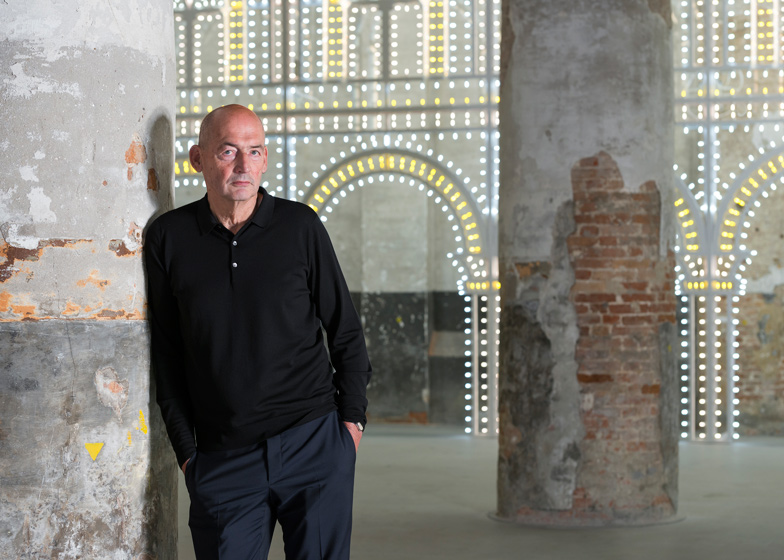Venice Architecture Biennale 2014: this year's biennale avoids contemporary architecture and has "nothing to do with design," curator Rem Koolhaas said yesterday while conducting a preview tour.
"I wanted to disconnect from contemporary architecture because I thought the architecture biennale was becoming very similar to the art biennale and that there was a kind of blur," said Koolhaas.
"It is nothing to do with design," he added, referring to the Elements of Architecture exhibition that forms the centrepiece of the biennale. "Zero. That is one of the pleasures of the exhibition, because just as architecture had been blurring with art it has also been blurring with design. In that sense it's a rare moment of segregation."
Called Fundamentals, the biennale sets out to "reconstruct how architecture finds itself in its current situation, and speculate on its future." It consists of three interlocking exhibitions: Elements of Architecture and Absorbing Modernity 1914-2014, both at the Giardini; and Monditalia, which is held at the Arsenale.
Koolhaas spoke as he gave a group of journalists including Dezeen a tour of Elements of Architecture, the showpiece exhibition located in the Central Pavilion in the Giardini. This individually examines fifteen elements that combine to create buildings, including stairs, ceilings, elevators and toilets.
"This exhibition has shocked me in terms of everything that I didn't know or everything I didn't think," said Koolhaas. "If you look at each element in isolation, it's actually scary."
Explaining the thinking behind the exhibition, Koolhaas said: "I've always been very interested in the effect of technology on architecture; I've written about the elevator, the escalator, air conditioning."
"But I met by coincidence an Italian scholar who was writing a PhD about the false ceiling and a German professor in Munich who wrote a book abut the history of the corridor. So when I was aware that my own interests were actually reflected elsewhere we decided to do an exhibition where every element is analysed from the beginning of time to the current moment and in certain cases even beyond."
The exhibition begins in the entrance to the pavilion where, beneath the newly restored dome, Koolhaas has suspended a section of a typical contemporary ceiling void complete with exposed air-handling pipes.
The contrast between the painted dome and the utilitarian pipes shows how architecture today typically involves working with "machinery over which the architect has very little control," Koolhaas said.
Each room in the exhibition examines a different element of architecture, and highlights the extent to which architecture today is about assembling pre-determined elements - a reality that has not really been recognised.
"The elevator or the escalator have never really been incorporated in either the ideology or the theory of architecture and now, with the new digital intersections, digital hybrids, digital combinations, the risk is that architecture is simply incapable of thinking of its entire repertoire," he said. "And that is what I hope will be the outcome of this exhibition: a modernisation of the core of architecture and architectural thinking as well."
The exhibition explores the history of each element and in some cases shows how elements might change in future as technology advances. The fireplace, for example, is brought up to date by the inclusion of a Nest digital thermostat.
"This is the moment where elements that have never spoken or never listened are turning into communicating elements," said Koolhaas. "I think it's the right moment in architecture to pose the question whether this is entirely desirable, or maybe not."
For the Absorbing Modernity 1914-2014 exhibition, held at the various national pavilions in the Giardini, Koolhaas briefed each nation to choose a moment in its history when "the process of modernisation was at its most acute."
"I called it Absorbing Modernity not as a grateful acceptance of a different condition but in the same way a boxer absorbs the blow of an opponent," Koolhaas said. "It is very much a typically enforced process."
The Dutch architect agreed to curate the biennale on two conditions, he said: "One of them was that I could disconnect from contemporary architecture, and the second one was [that I was given] more time."
The longer preparation time allowed Koolhaas and the national pavilions to properly prepare a response to the brief.
"It enabled me to talk to the nations, the national pavilions, and to convince them actually without any effort," he said. "It was almost more like relief. The nations actually took it seriously and there is a number of pavilion which really in my eyes are sensational," citing the Korean and Japanese pavilions as outstanding examples.
But Koolhaas was at pains to point out that the exhibition is not about Modernism. "The word modernism is avoided in every single publication," he said. "Modernism is a long-ago aesthetic movement that some of us may have sympathy for but which none of us are really engaged with."
The third element of the biennale, the Monditalia exhibition at the Arsenale, presents a kind of mash-up of all the other biennales held in Venice and focusses on Italy.
"You will see that the Arsenale is not occupied by architecture, it is occupied by an event that mobilises all the other biennales, dance, theatre, music and film,' said Koolhaas. "You see a range of 80 movies and 40 architecture projects that represent the scale of Italy. I exploited the length of the Arsenale and cut it into parts, so that starting from the south you get a sense of the condition of this country."
Fundamentals, the 14th International Architecture Exhibition, opens to the public on June 7 and continues until 23 November.
Follow our coverage of this year's Venice Architecture Biennale »
Image credit: Rem Koolhaas in front of Luminaire by OMA in collaboration with Swarovski, (c) Gilbert McCarragher.

